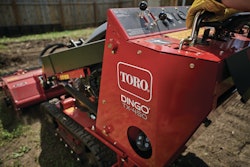Biodiesel, a fuel derived from soybeans or other oil-producing plants, may be coming to a truck near you. Thanks in part to federal emissions regulations set to go into effect in 2007, this alternative fuel is increasingly available, and automotive and equipment manufacturers are taking notice.
By the end of 2005, John Deere will be using B2, a blend of 2 percent biodiesel and 98 percent regular diesel, as the preferred factory-fill in all of its diesel machines produced in the U.S.
“All of our manufacturing plants in the U.S. will use B2 biodiesel to fuel our combines, tractors and other diesel-powered machines,” says Don Borgman, market planning manager for John Deere. Several plants have already converted, and the remainder will be online by the end of the year.
Dodge is getting into the game, too. A Cummins-powered Dodge Ram pickup truck that runs on B5 biodiesel was recently featured during a presidential visit to a diesel refinery in Virginia.
“The option of running the Cummins 610 Turbo Diesel with B5 biodiesel in the Dodge Ram will be seen as a significant step forward in encouraging greater use of renewable fuel,” Jeff Caldwell, Cummins executive director of DaimlerChrysler business, said in a statement.
B5 biodiesel – a blend of 5 percent pure biodiesel with 95 percent standard diesel – is the most commonly accepted specification for heavy-duty engines. In 2004 Cummins produced over 150,000 of the 610 Turbo Diesel engines for DaimlerChrysler, which manufactures the Dodge Ram.
The National Biodiesel Board is pleased with the progress.
“The biodiesel-blend factory fills announced by John Deere and DaimlerChrysler show that manufacturers are beginning to recognize the valuable role that biodiesel can play in marketing diesel vehicles to Americans,” says Jenna Higgens, director of communications for the NBB. “We have worked with equipment manufacturers for years in getting positive warranty position statements on biodiesel that won’t leave the consumer confused, and it continues to be one of our top priorities as an industry.”
According to Higgens, biodiesel can be used in any diesel engine with few or no modifications, including heavy equipment.
“In fact, construction companies are beginning to show interest in biodiesel. In Colorado, the use of biodiesel helps construction companies qualify for the Built Green program, which is a marketing tool builders can use for ecologically friendly commercial and residential buildings,” Higgens said.
“Using biodiesel engines reduces our dependency on imported oil, and it brings economic opportunities to U.S. farmers who grow crops like soybeans and mustard seed which are used to make the fuel,” says Christine Vujovich, vice president of marketing and environmental policy at Cummins.
But does biodiesel make performance suffer? Not according to the Department of Energy, which says horsepower, torque, acceleration, cruising speed, and fuel economy are similar to those for regular diesel fuel.
Some 500 fleets across the country are already using the alternative fuel, including the U.S. Postal Service and the U.S. Departments of Defense, Energy and Commerce. Federal and state tax breaks for alternative fuel fleets and vehicles are credited by the DOE with making the switch easier for many of the hundreds of school districts, transit authorities, national parks, public utilities, and garbage and recycling companies.
Shifts like these help explain why consumption of biodiesel shot up from 500,000 gallons in 1999 to 30 million gallons in 2004. The DOE expects demand to grow to 5 billion gallons a year by 2012 for biodiesel and ethanol.
The benefits may add up, but where do you gas up? There are more than 300 retail filling stations that offer the fuel to the public, and hundreds of petroleum distributors across the country carry it. The DOE’s Alternative Fuels Data Center offers an online Station Locator that maps each station in the country that offers various types of fuel, including biodiesel.










